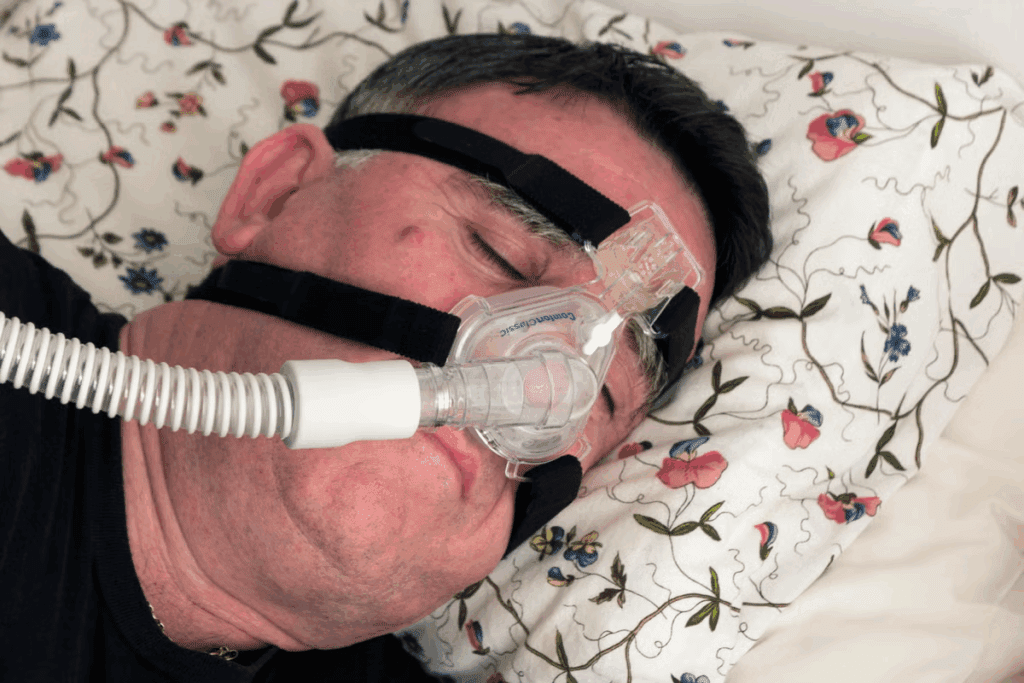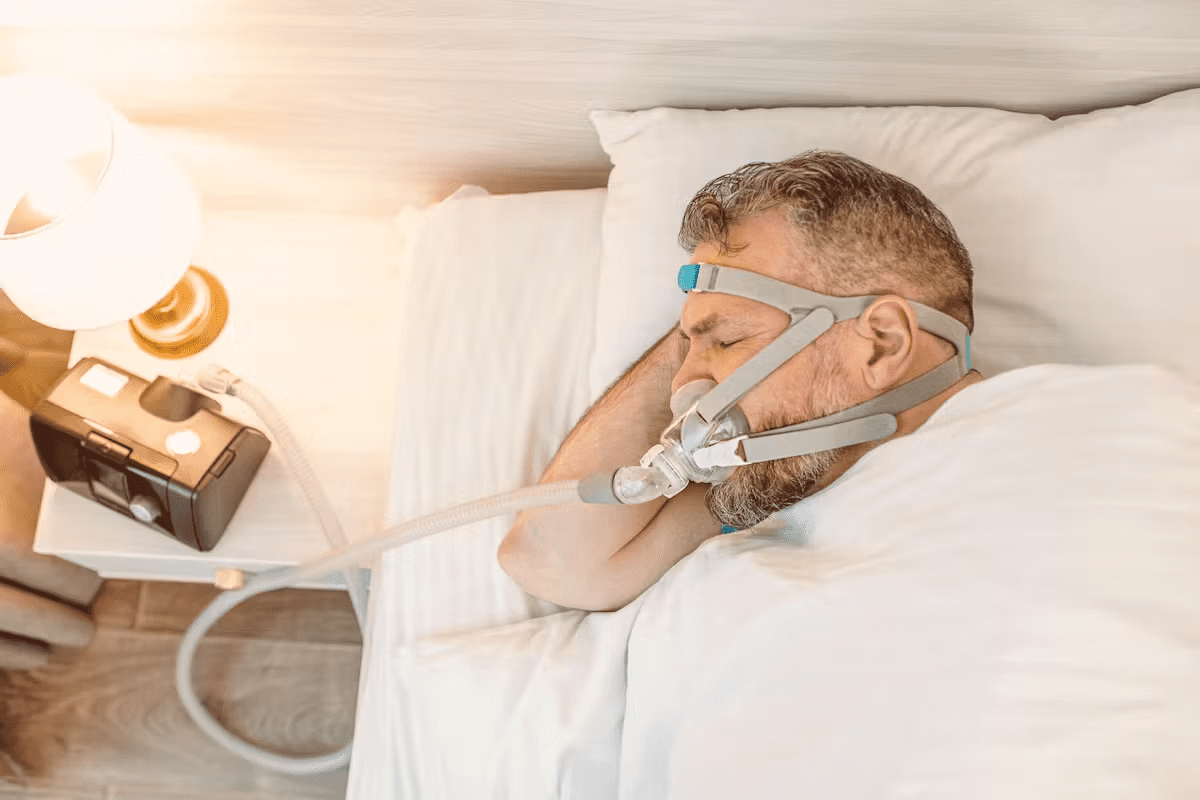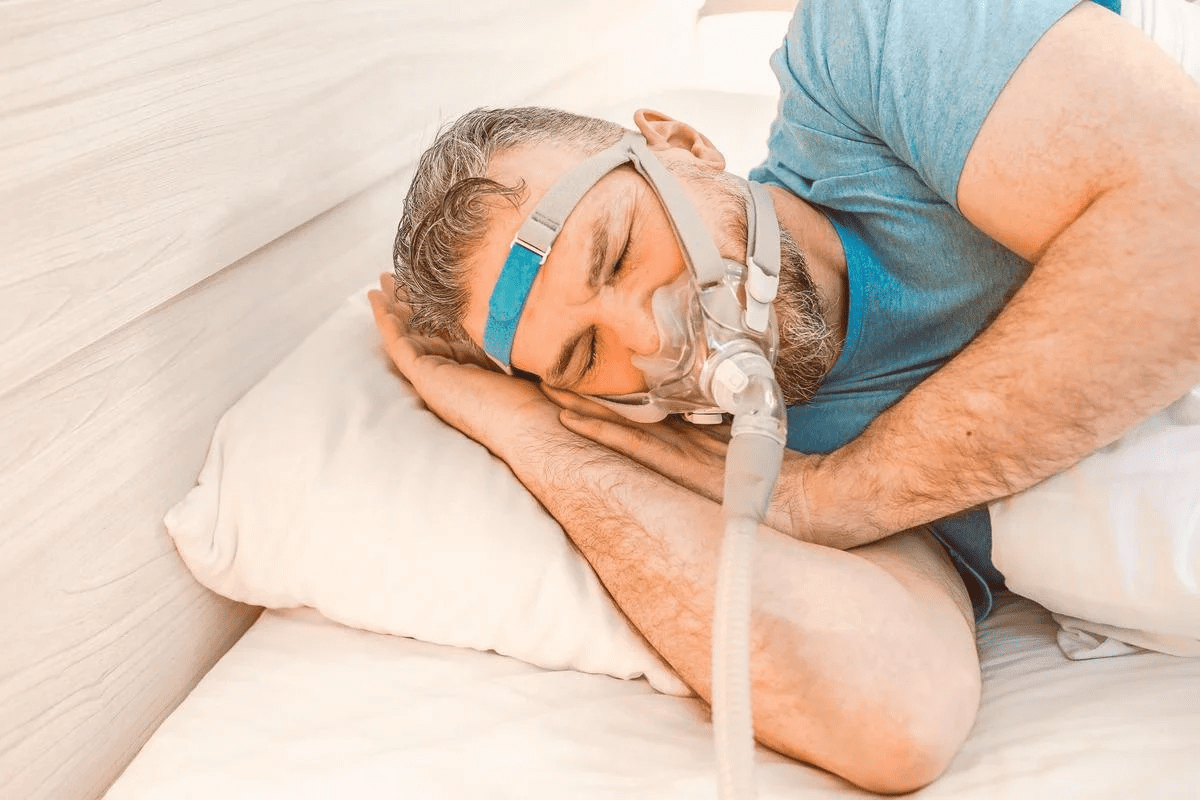
Snoring is a big problem for millions of adults around the world. It not only bothers the person who snores but also their sleep partners. Snoring can be a sign of a serious condition called sleep apnea, which needs doctor’s care.
Continuous Positive Airway Pressure (CPAP) therapy is a top choice for treating snoring linked to sleep apnea. Studies show that more than 90% of people using CPAP saw a big drop in snoring intensity and frequency.
At Liv Hospital, we know how important it is to get a correct diagnosis and treatment. Even though CPAP is mainly for sleep apnea, it can also help with snoring. Knowing why someone snores is key to finding the right treatment.
Can CPAP stop snoring? Yes, but snoring relief is a side effect of its primary function: treating obstructive sleep apnea.

Snoring and sleep apnea are linked by many physiological factors. Snoring is not just a simple annoyance. It often signals a more serious issue, like obstructive sleep apnea (OSA).
Snoring happens when the throat’s tissues relax and vibrate. This is because the airway is partially blocked. Obesity, nasal congestion, or anatomical issues can cause this blockage.
Key factors contributing to snoring include:
Sleep apnea, mainly obstructive sleep apnea (OSA), is closely related to snoring. OSA happens when the airway is blocked during sleep. This leads to pauses in breathing or shallow breathing. Snoring is a common sign of OSA, as the same throat relaxation causes both.
It’s important to note that while snoring is a symptom of sleep apnea, not all snorers have sleep apnea. Snoring is a common sign of obstructive sleep apnea. But, having snoring alone doesn’t mean someone has OSA.
Regular snoring is different from sleep apnea. Snoring is caused by the vibration of throat tissues due to partial airway blockage. Sleep apnea, on the other hand, involves complete or near-complete pauses in breathing.
The Sleep Foundation explains that snoring is caused by relaxed throat tissues vibrating during breathing. Sleep apnea happens when breathing stops or slows during sleep due to a blockage. Knowing this difference is key for proper diagnosis and treatment.
Key differences include:

CPAP therapy uses a machine to send pressurized air. It helps those with sleep apnea, a condition where breathing stops or gets shallow during sleep.
CPAP machines send air through a tube to a mask. This mask covers the nose and sometimes the mouth. The air keeps the airway open, stopping breathing pauses in sleep apnea.
This ensures a normal breathing pattern at night. It greatly improves sleep quality.
There are many CPAP devices for different needs. The standard CPAP delivers constant air pressure. Auto-CPAP machines adjust air pressure as needed.
BiPAP machines offer two air pressures for breathing in and out. The right device depends on sleep apnea severity and comfort.
CPAP treatment’s main goal is to treat sleep apnea symptoms. These include loud snoring, morning headaches, and tiredness during the day.
It keeps the airway open, improving sleep. CPAP also lowers the risk of health problems like heart disease and brain issues. Though it doesn’t cure sleep apnea, it’s a key treatment for many.
Research shows that CPAP therapy greatly cuts down snoring in people with sleep apnea. This is backed by a lot of clinical studies. They prove CPAP is good at stopping snoring caused by sleep apnea.
Many studies have looked into how CPAP affects snoring. The results are clear: CPAP works well to lessen snoring. Clinical trials have shown that CPAP therapy can lead to a significant decrease in snoring episodes, making sleep better for both the patient and their partner.
One study found CPAP therapy cut snore frequency from 1,015 to 23 snores per night. This big drop shows CPAP can almost stop loud snoring in sleep apnea patients. The implications of this finding are significant, as it suggests that CPAP can greatly improve the sleep environment.
CPAP therapy has a high success rate in reducing snoring, with a 90% success rate in studies. This success is because CPAP machines keep airway pressure steady. This stops the airway from collapsing, which causes snoring.
By looking at the clinical evidence for CPAP therapy, people can make better choices for treating snoring and sleep apnea.
CPAP therapy works better for some snorers than others. It’s more effective for those with sleep apnea than for others. We’ll look at how CPAP helps different types of snorers and who gets the most benefit.
There are two main types of snoring: sleep apnea-related and simple snoring. Sleep apnea causes breathing pauses or shallow breathing during sleep. Simple snoring doesn’t have these pauses but can also disrupt sleep. CPAP therapy is mainly for sleep apnea-related snoring.
People with sleep apnea-related snoring get the most from CPAP. It keeps their airways open, preventing breathing pauses. The Sleep Foundation says CPAP works best for those with moderate to severe sleep apnea. For them, CPAP can greatly improve sleep and health.
For simple snoring not linked to sleep apnea, CPAP might not be the best choice. Other treatments like lifestyle changes or oral appliances could be better. It’s key to talk to a healthcare professional to find the right treatment. CPAP should only be used with a doctor’s guidance to ensure it’s the right fit.
Starting CPAP therapy is a journey that needs patience and understanding. As you begin, several things are important for its success.
The first few weeks are key. Getting used to wearing a mask over your nose and/or mouth at night can be tough. You might feel uncomfortable, claustrophobic, or struggle to fall asleep. But, most people get used to it in a few weeks.
To get used to CPAP therapy, start by wearing the mask during the day. Practice wearing it for longer periods until you’re comfortable. Also, getting used to the machine’s noise and the airflow feeling helps a lot.
Finding the right pressure setting is key for CPAP therapy to work well. This might involve a sleep study or a titration process. The pressure is adjusted during sleep to find the best setting.
Pressure Setting | Description | Benefits |
Low Pressure | Starting point for most users | Comfortable for initial adaptation |
Optimal Pressure | Determined through titration | Effective in reducing sleep apnea events |
High Pressure | For severe sleep apnea cases | Ensures airway patency |
Success with CPAP therapy shows in many ways. You might notice less snoring, better sleep, and more energy during the day. It’s important to check in with your healthcare provider regularly. They can help see if the therapy is working and make changes if needed.
CPAP therapy is very effective but comes with some drawbacks. It’s important to know about these side effects. With the right help and adjustments, many of these issues can be solved.
Many CPAP users complain about mask discomfort. Finding a mask that fits right can be hard. An ill-fitting mask can cause discomfort, skin irritation, and air leaks.
Manufacturers offer different mask styles and sizes. It’s key for users to work with their healthcare provider to find the best mask.
Nasal congestion and dry mouth are common side effects. These problems can happen because of the air pressure in the nasal passages. Using a heated humidifier can help by adding moisture to the air.
This can reduce irritation and discomfort. Some users might feel claustrophobia or anxiety from wearing the mask. This can be helped by getting used to it slowly and with support.
Studies show that 30-70% of CPAP users face side effects. These can range from mild to severe. The reasons for this vary, including the mask type, pressure settings, and how well the user tolerates the therapy.
Understanding these side effects is vital for better CPAP treatment satisfaction. Healthcare providers can help users adjust to CPAP therapy. This can lead to long-term success with the treatment.
CPAP therapy is a top choice for treating sleep apnea. Yet, many struggle to stick with it. Despite its benefits, a lot of people stop using CPAP within a few years.
Research shows that 12-25% of users quit CPAP therapy in three years. This is a big worry, as using it regularly is key to managing sleep apnea. It’s important for doctors to find out why people stop using CPAP.
Many reasons lead to quitting CPAP. Discomfort, noise, and feeling trapped in the mask are common. Some also face issues like nasal congestion or dry mouth.
Psychological factors also affect CPAP use. Anxiety, stress, and feeling self-conscious about wearing a CPAP can make it hard to keep using it. Adjusting to a new routine and feeling like it intrudes on personal space can also be tough.
Overcoming these psychological barriers is key to better CPAP use. Doctors can offer support and counseling. Teaching patients about CPAP’s benefits and involving them in treatment planning can also help.
To boost CPAP use, we need to tackle both physical and mental hurdles. Ensuring the CPAP mask fits right is a big step. Regular check-ins with doctors can catch and fix problems early.
By using these strategies, doctors can help patients stay on track with CPAP therapy. This can lead to better treatment results and a better quality of life.
Snoring can be treated in many ways, with CPAP being well-known. But, for those who can’t use CPAP or prefer other methods, there are alternatives.
Looking for CPAP alternatives? You have options like oral appliances, positional therapy, surgery, and lifestyle changes. Each has its own benefits and drawbacks.
Oral appliances are custom-made to keep the airway open while sleeping. They work well for mild to moderate sleep apnea and snoring. Positional therapy helps by preventing sleeping on your back, which can make snoring worse.
Oral Appliance vs. CPAP: Oral appliances are liked by those who find CPAP machines hard to use or uncomfortable. Research shows they can be as good as CPAP in reducing snoring and improving sleep quality for some.
Surgery is considered for severe snoring or sleep apnea that hasn’t responded to other treatments. It aims to remove or reduce airway obstructions.
Surgical Considerations: Surgery is usually a last choice because of risks and recovery time. But, for some, it can be very effective.
Lifestyle changes can greatly affect how much you snore. Losing weight, exercising regularly, avoiding alcohol before bed, and sleeping on your side are key.
Complementary Lifestyle Changes: Even with CPAP, lifestyle changes can make treatment better. For example, losing weight can make CPAP more effective by reducing sleep apnea severity.
To understand the differences between CPAP and other treatments, let’s look at a table:
Treatment | Effectiveness for Snoring | Patient Comfort | Cost |
CPAP Therapy | High | Variable | Moderate to High |
Oral Appliances | High for mild to moderate snoring | Generally High | Moderate |
Positional Therapy | Moderate | High | Low to Moderate |
Surgical Options | High for severe cases | Variable, depends on procedure | High |
Lifestyle Changes | Variable, can be high | N/A | Low to Moderate |
In conclusion, while CPAP is a top choice for snoring treatment, there are other options. The right choice depends on your condition and what you prefer. Always talk to a healthcare professional to find the best treatment for you.
CPAP therapy is common, but safety worries exist. We need to tackle these concerns head-on. This is for those thinking about or already using CPAP machines.
CPAP therapy has its own risks and side effects. It’s key for patients to know these to make smart choices about their treatment.
Many myths about CPAP machines scare people away. Let’s clear up these myths with facts to ease worries.
Keeping CPAP machines clean and well-maintained is vital. Regular cleaning stops bacteria and pathogens from growing.
Maintenance Task | Frequency | Importance |
Cleaning the Mask | Daily | High |
Replacing Filters | Weekly/Monthly | High |
Inspecting Tubing | Weekly | Medium |
CPAP therapy does more than just treat sleep apnea. It can greatly improve personal relationships and quality of life. A good night’s sleep can positively affect many areas of daily life.
One key benefit of CPAP therapy is less snoring. This can greatly improve bedroom harmony and partner satisfaction. Studies show that partners often report better sleep and less frustration.
Improved sleep quality also makes relationships better. It reduces irritability and boosts energy. This makes it easier to do things together.
CPAP therapy greatly improves sleep for those with sleep apnea. It ensures uninterrupted sleep, making users feel more alert during the day. The Sleep Foundation notes that CPAP improves sleep quality and daytime functioning.
These improvements can lead to better work performance, mood, and overall well-being. Benefits include:
While CPAP therapy has many benefits, it also has challenges. Users face issues like mask discomfort, machine noise, and maintenance needs. Understanding these challenges is key to getting the most from CPAP therapy.
Benefits | Inconveniences |
Improved sleep quality | Mask discomfort |
Reduced snoring | Machine noise |
Enhanced daytime functioning | Regular maintenance needs |
By considering both sides, individuals can make better treatment choices. Working with healthcare providers can help overcome challenges. This way, they can improve their quality of life with CPAP therapy.
It’s important for patients to understand the long-term effects of CPAP therapy. We need to look at how long CPAP treatment lasts and how it can be adjusted. Different factors can affect how long someone uses a CPAP machine.
In some cases, you might not need to use a CPAP machine forever. If you lose a lot of weight or have surgery, you might not need it anymore. But, always talk to a doctor before making any changes.
A study in the Journal of Clinical Sleep Medicine found that weight loss can help some stop using CPAP. Here are some key findings from that study.
Weight Loss Category | Percentage of Patients Able to Discontinue CPAP |
Less than 10% body weight loss | 12% |
10-20% body weight loss | 35% |
More than 20% body weight loss | 60% |
It’s important to see your doctor regularly to check if you need to keep using a CPAP machine. These visits help make sure your treatment is working well and is comfortable for you.
Key factors to discuss during these reassessments include:
CPAP therapy is getting better with new technology. Modern CPAP machines have features like:
As technology keeps improving, CPAP therapy will likely become even more tailored and effective. This could change how we treat sleep apnea and snoring in the long run.
CPAP therapy is a top choice for treating snoring, often linked to sleep apnea. Studies show it can greatly cut down snoring in most users. Knowing how CPAP works and its benefits helps people choose the right treatment.
Before starting CPAP, talk to a doctor to find the best treatment for you. The Sleep Foundation advises this to get the best results. This way, you can understand CPAP’s pros and cons and decide if it’s right for you.
Choosing CPAP for snoring means looking at how it can improve your sleep and health. By learning more and talking to doctors, you’re on your way to better sleep and quieter nights.
CPAP machines are safe when used right and kept up. But, like any medical device, they can have risks and side effects.
Yes, CPAP therapy greatly reduces snoring caused by sleep apnea. Studies show a big drop in snores at night for users.
For many, CPAP is a long-term treatment. But, some might stop using it after a doctor’s check-up.
Side effects include mask discomfort, nasal congestion, and dry mouth. Getting the right fit and keeping it up can help.
CPAP is mainly for sleep apnea. For simple snoring, oral appliances or lifestyle changes might be better.
To improve, get a good mask fit, adjust slowly, and tackle any mental barriers to using it every day.
Yes, options include oral appliances, positional therapy, surgery, and lifestyle changes. The best choice depends on the snoring cause and patient needs.
For many, sleep apnea needs ongoing care. CPAP therapy can be a long-term solution if used correctly and consistently.
Yes, CPAP can make life better by reducing snoring and improving sleep. This leads to better daytime function and relationships.
Cleaning and upkeep are key for safety and effectiveness. Follow the maker’s cleaning guide for mask, tubing, and humidifier.
New tech includes more comfy masks, auto-adjusting pressure, and better humidification. These make CPAP therapy more comfortable and effective.
Yes, CPAP can help kids with sleep apnea. There are special masks and settings for kids, and treatment should be under a pediatric sleep specialist.
For many, CPAP is a long-term or lifelong treatment. But, some might stop using it after a doctor’s review. It varies by individual condition and treatment response.
Baugh, R. F., Archer, S. M., Mitchell, R. B., Rosenfeld, R. M., Amin, R.,侧. R., . . . Witsell, D. L. (2011). Clinical Practice Guideline: Tonsillectomy in Children. Otolaryngology—Head and Neck Surgery, 144(1 Suppl), S1-S30. Retrieved from https://journals.sagepub.com/doi/full/10.1177/0194599810389949
Subscribe to our e-newsletter to stay informed about the latest innovations in the world of health and exclusive offers!
WhatsApp us